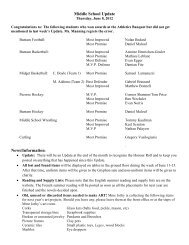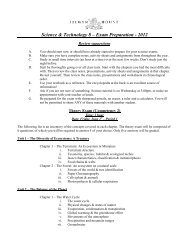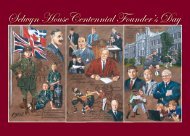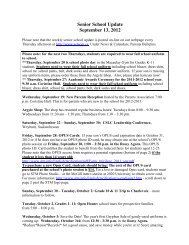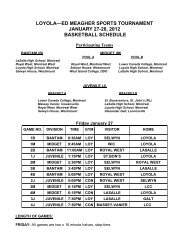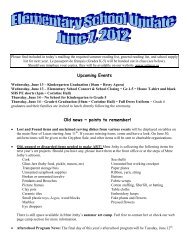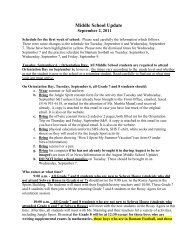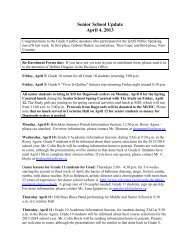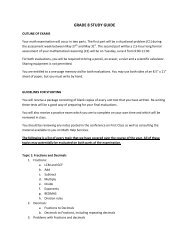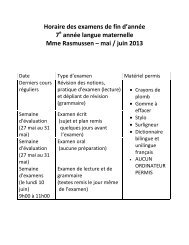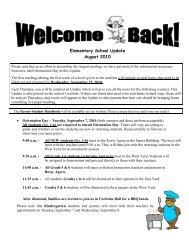Senior English Critical Writing Handbook - Selwyn House School
Senior English Critical Writing Handbook - Selwyn House School
Senior English Critical Writing Handbook - Selwyn House School
You also want an ePaper? Increase the reach of your titles
YUMPU automatically turns print PDFs into web optimized ePapers that Google loves.
explaining the technique of a literary work to a friend of your own age and ability. Use literaryterms mostly as a basis for the generalizations you intend to support in your essay.Point of ViewFormal <strong>English</strong> must be written from the objective point of view: the writer must not refer tohimself nor draw attention explicitly to the methods he follows; he must keep his own and hisreader’s attention solely on the literary work about which he is writing. (Such attention to theobject he is looking at explains why the writer of formal <strong>English</strong> is said to take the objectivepoint of view; the opposite, or subjective point of view, directs attention to the observer, thesubject.) Nowhere in your essay ought you to use first-person, personal pronouns (I, me, mine).Use instead such anonymous terms as the reader, the speaker, one, the observer, _a person; orcouch your sentence in the form of an opinion that does not say it is an opinion (instead of “Ithink this plot is weak,” for example, say, “This plot is weak.”). Here is an introductory paragraphthat violates the convention about point of view:In my essay on imagistic motifs in Macbeth, I have chosen to discuss the motif of sleep and death. A motif is arecurring image that helps to unify a play or novel and that gives additional force to its theme. In my essay, I amgoing to give four examples of the motif of sleep and death and talk about each one.Re-written in correct style, this paragraph might read as follows:Shakespeare uses imagistic motifs, resonating patterns of imagery, to help unify his plays and to present their themesmore forcibly. One of the most important of these motifs in Macbeth associates sleep with death, as in the phrase,“sleep, death’s counterfeit.” As the play develops, the likeness of sleep to death shifts from benevolence (sleep anddeath appear as “balms” for the sores inflicted by fate) to malevolence (sleep and death are the occasions for hellishpunishment), until finally both Macbeth and his lady approach the “death” of insanity, marked for Macbeth byinsomnia and for Lady Macbeth by sleep-walking.In comparing these two paragraphs, notice especially that the theses with which they end contrastwidely in objectivity: the first draws attention to the writer and his methods; the second looksonly at the topic.Sentence StructureFormal <strong>English</strong> is grammatically more complex than informal <strong>English</strong> or slang because it is usedto speak about ideas and the relationships between ideas. It is useful to think about presentingideas (generalizations) in simple principal clauses and the relationships between ideas insubordinate structures, often signalled by specific conjunctions. The point is to say as much aspossible about ideas and their relationships, but to say it in as few words as possible. Tryespecially to avoid writing a succession of simple sentences (choppy style) or a succession ofcompound sentences, since both these practices leave the reader to determine for himself whatthe relationships between ideas are, the one by providing no conjunctions, the other by providingconjunctions like “and” and “or” that put ideas on equally important levels.It is extremely valuable for the young writer, therefore, to work extensively at learning how tocombine groups of simple sentences and to increase his awareness of sentence types available forthis purpose. He ought to try, for example, to begin many of his sentences with another elementthan the subject, to write using colons and semicolons correctly, and to form parallelismsproperly.14



